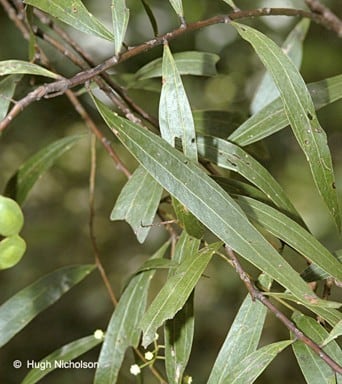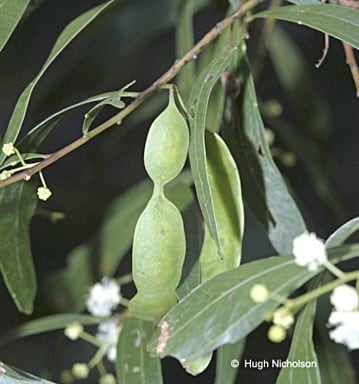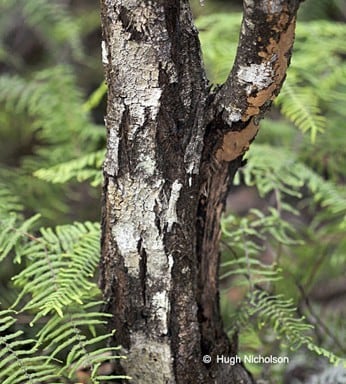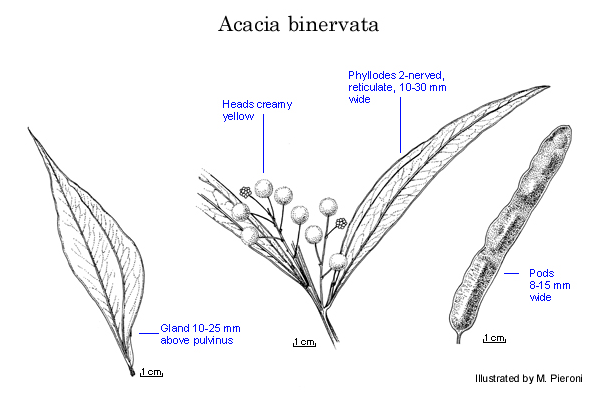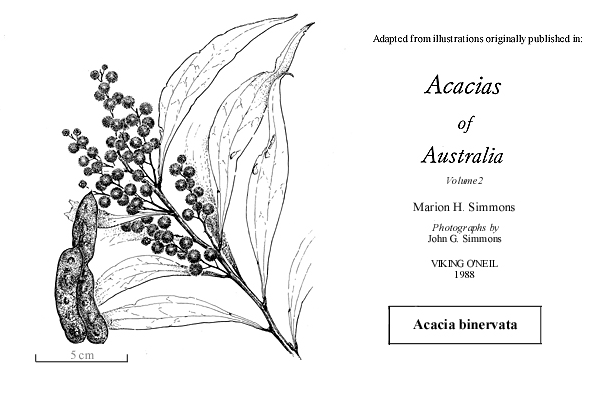Acacia binervata DC.
WATTLE
Acacias of Australia
Common Name
Two-veined Hickory
Family
Fabaceae
Distribution
Extending from near Narooma, N.S.W., N to Mt Tamborine in south-eastern Qld. Predominates in coastal areas favouring moist sites in tall forests and margins of rainforests.
Description
Bushy shrub or tree 3–10 m high. Bark brown to grey. Branchlets glabrous. Phyllodes narrowly ovate to narrowly elliptic, straight to shallowly falcately recurved, 6–16 cm long, usually 1–3 cm wide, acuminate, thin, glabrous, prominently 2-nerved per face, sometimes a less prominent third nerve present, with minor nerves forming a fine open reticulum; gland 1–2.5 cm above pulvinus; margin commonly indented at gland which often touches the adaxial longitudinal nerve or is connected to it by a fine oblique nerve. Inflorescences 7–12-headed racemes, sometimes in panicles; raceme axes (1.5–) 3–6 (–8) cm long, glabrous or subglabrous, sometimes growing out; peduncles (4–) 6–12 mm long, glabrous; heads globular, 15–25-flowered, pale yellow to ±white. Flowers 5-merous; sepals united. Pods to 14 cm long, 8–15 mm wide, thinly crustaceous-coriaceous, glabrous. Seeds longitudinal, oblong-elliptic, c. 5 mm long, slightly shiny, black; funicle thickly filiform, 1/2 to wholly encircling seed, black (dry); aril clavate.
Specimens
Qld: Tamborine Heights Estate, c. 64 km S of Brisbane, J.Aagard (BRI); McPherson Ra., Springbrook, Purling Brook Falls, P.Beesley 1013 & P.Ollerenshaw (NSW). N.S.W.: near Mittagong, Oct. 1963, H.Boyd (PERTH); 1.6 km S of Woolgoolga, R.Coveny 3838 & K.Thurtell (NSW, PERTH).
Notes
Popular in cultivation.
Specimens from young trees at Stanwell Park, N.S.W., (e.g. J.H.Maiden, NSWl67344, PERTH) have atypically broad phyllodes (to 5 cm wide).
Very similar to A. penninervis var. longiracemosa which has 1-nerved phyllodes and short funicles not encircling the seeds. Allied to A. wardellii; these two species seem closely allied to certain members of the ‘A. microbotrya group’ but are readily distinguished by their 2- or 3-nerved phyllodes.
FOA Reference
Data derived from Flora of Australia Volumes 11A (2001), 11B (2001) and 12 (1998), products of ABRS, ©Commonwealth of Australia
Author
Minor edits by B.R.Maslin
B.R.Maslin
This identification key and fact sheets are available as a mobile application:
URL: https://apps.lucidcentral.org/wattle/
© Copyright 2018. All rights reserved.
